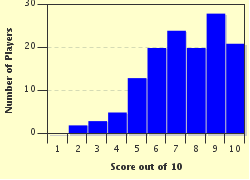Quiz Answer Key and Fun Facts
1. Some stars are blue, others red, and yet others are yellow. What causes stars to be so many different colors?
2. If you were to enter a black hole, you would be 'spaghettified'. What would happen to you?
3. The moon has an odd pattern of orbit and rotation. This causes one moon day to equal one moon what?
4. The moon has different phases. If the moon is in its waning gibbous phase, what does it look like?
5. Stars use nuclear fusion (fusing elements to make other ones in their core) throughout their life. What causes them to die?
6. A blue moon is a rare occurrence. What is a blue moon?
7. At the beginning of *2016*, which planet in our solar system was believed to have the most moons?
8. Pluto used to be the smallest planet in our solar system, until it was downgraded to a dwarf planet. Which planet is the smallest in 2016?
9. Scientists believe that there is a black hole in the center of every spiral galaxy.
10. What kind of galaxy is the Milky Way?
Source: Author
druellablack
This quiz was reviewed by FunTrivia editor
rossian before going online.
Any errors found in FunTrivia content are routinely corrected through our feedback system.


